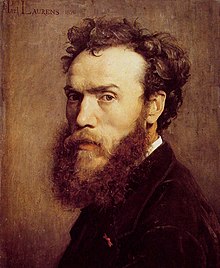Jean-Paul Laurens
This article has multiple issues. Please help improve it or discuss these issues on the talk page. (Learn how and when to remove these template messages)
|
Jean-Paul Laurens | |
|---|---|
 Self-portrait | |
| Born | 28 March 1838 Fourquevaux, France |
| Died | 23 March 1921 (aged 82) Paris, France |
| Known for | Painting |

Jean-Paul Laurens (French pronunciation: [ʒɑ̃pol loʁɑ̃]; 28 March 1838 – 23 March 1921) was a French painter and sculptor, and one of the last major exponents of the French Academic style.
Biography
Laurens was born in Fourquevaux and was a pupil of Léon Cogniet and Alexandre Bida. Strongly anti-clerical and republican, his work was often on historical and religious themes, through which he sought to convey a message of opposition to monarchical and clerical oppression. His erudition and technical mastery were much admired in his time, but in later years his highly realistic technique, coupled to a theatrical mise-en-scène, came to be regarded by some art-historians as overly didactic. More recently, however, his work has been re-evaluated as an important and original renewal of history painting, a genre of painting that was in decline during Laurens' lifetime.
Laurens was commissioned to paint numerous public works by the
Laurens was highly respected teacher at the Académie Julian, Paris, and a professor at the École nationale supérieure des Beaux-Arts in Paris, where he taught André Dunoyer de Segonzac and George Barbier. He died in Paris, aged 82. Two of his sons, Paul Albert Laurens (1870–1934) and Jean-Pierre Laurens (1875–1932), both also became painters and teachers at the Académie Julian.
Notable students
- Moussa Ayoub[1]
- Marjorie Bates[2]
- Emilio Boggio
- Catharine Carter Critcher
- Cecilia Cutescu-Storck
- Angèle Delasalle
- Georges Dufrénoy
- Ludwig Deutsch
- Sears Gallagher
- 'Harry' Phelan Gibb
- Kahlil Gibran
- Thomas Cooper Gotch
- Louise Herreshoff[3]
- Christian Herter of Herter Brothers
- Will Hutchins
- A. Y. Jackson
- Gustave Louis Jaulmes
- Alfred Garth Jones
- Leon Kroll
- Mortimer Lichtenauer
- Arturo Michelena
- Ella Ferris Pell[3]
- Cristóbal Rojas
- Robert Poughéon
- Alexander Rummler
- Paul Sibra
- René Schützenberger
- William Somerville Shanks
- Aurélia de Souza
- Sofia Martins de Sousa
- Henry Scott Tuke
- Karl Yens
- John Goodwin Lyman
References
- ISBN 978-0-19-977378-7. Retrieved 16 March 2020.
- ^ Bates at Panvertu.com Archived 12 April 2019 at the Wayback Machine accessed 29 December 2007
- ^ ISBN 978-0-940979-01-7.
Further reading
- Desjardins, M. H. (2004). Des peintres au pays des falaises 1830–1940 (in French). Fécamp: Éditions des falaises. pp. 108–114.
- Jean-Paul Laurens 1838–1921, peintre d'histoire, Catalogue d'exposition, Musée d'Orsay (in French). Paris: RMN. 1997.
